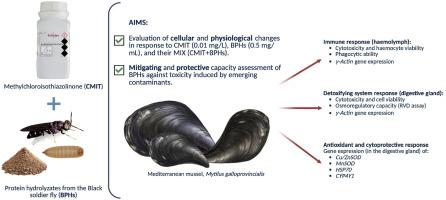Novel sustainable strategies to mitigate toxicity of emerging contaminants: cellular and physiological insights from CMIT-exposed mussels treated with insect-based protein hydrolysates
IF 5.8
2区 化学
Q2 CHEMISTRY, MULTIDISCIPLINARY
引用次数: 0
Abstract
The present interest in developing sustainable strategies to mitigate or prevent toxicity of emerging contaminants is attributable to their increasing occurrence in natural ecosystems. Beyond their established roles in the agri-food, feed, and biotechnology sectors, insects are emerging as valuable sources of bioactive compounds, highlighting their recognition as sustainable solutions in nutraceutical and pharmaceutical research. Therefore, the effects of protein hydrolysates from the black soldier fly, Hermetia illucens (BPHs) were evaluated against the toxicity induced by the methylchloroisothiazolinone (CMIT), a widely used biocides belonging to the isothiazolinones class of the biocides. Analyses focused on the modulation of key cellular and physiological parameters in Mytilus galloprovincialis exposed to CMIT (0.01 mg/L), BPHs (0.5 mg/mL), and their mix. Changes in haemocyte functions were assessed through cell viability assays and phagocytosis assay along with the expression of γ-actin; investigation into digestive gland (DG) functionality was carried out by measuring the viability of DG cells and their ability to perform osmoregulation after a hypotonic shock through the Regulatory Volume Decrease video-metric assay (RVD); antioxidant and cytoprotective responses were evaluated through the Cu/ZnSOD, MnSOD, Hsp70, and CYP4Y1 gene expression analysis. Our findings showed that BPHs play a significant protective role against toxicity induced by CMIT in exposed mussels. Significant differences emerged between the control and the CMIT-treated groups, whereas a similar trend was observed between the CTRL and BSPHs-exposed groups. Groups exposed to the combinations (BPHs + CMIT) showed a recovery, suggesting the protective effect of this compound.

减轻新出现污染物毒性的新型可持续策略:用昆虫蛋白水解物处理的cmit暴露贻贝的细胞和生理见解
目前对制定可持续战略以减轻或防止新出现的污染物的毒性的兴趣是由于它们在自然生态系统中越来越多地出现。除了在农业食品、饲料和生物技术领域的既定作用外,昆虫正在成为生物活性化合物的宝贵来源,突出表明它们在营养保健和制药研究中被视为可持续的解决方案。因此,对黑兵蝇(Hermetia illucens, BPHs)蛋白水解物对甲基氯异噻唑啉酮(methylchloroisothiazolinone, CMIT)的毒性进行了评价。甲基氯异噻唑啉酮是一种广泛使用的杀菌剂,属于异噻唑啉酮类。重点分析了CMIT (0.01 mg/L)、BPHs (0.5 mg/mL)及其混合物对紫贻贝(Mytilus galloprovincialis)关键细胞和生理参数的影响。通过细胞活力测定、吞噬测定以及γ-肌动蛋白的表达来评估血细胞功能的变化;通过调节体积减少视频测量法(RVD)测量消化腺(DG)细胞的活力及其在低渗休克后进行渗透调节的能力,研究了消化腺(DG)的功能;通过Cu/ZnSOD、MnSOD、Hsp70和CYP4Y1基因表达分析,评价其抗氧化和细胞保护作用。我们的研究结果表明,BPHs对暴露于CMIT的贻贝具有显著的保护作用。在对照组和cmit处理组之间出现了显著差异,而在CTRL和bsphs暴露组之间观察到类似的趋势。暴露于组合(BPHs + CMIT)组显示恢复,表明该化合物的保护作用。
本文章由计算机程序翻译,如有差异,请以英文原文为准。
求助全文
约1分钟内获得全文
求助全文
来源期刊

Sustainable Chemistry and Pharmacy
Environmental Science-Pollution
CiteScore
8.20
自引率
6.70%
发文量
274
审稿时长
37 days
期刊介绍:
Sustainable Chemistry and Pharmacy publishes research that is related to chemistry, pharmacy and sustainability science in a forward oriented manner. It provides a unique forum for the publication of innovative research on the intersection and overlap of chemistry and pharmacy on the one hand and sustainability on the other hand. This includes contributions related to increasing sustainability of chemistry and pharmaceutical science and industries itself as well as their products in relation to the contribution of these to sustainability itself. As an interdisciplinary and transdisciplinary journal it addresses all sustainability related issues along the life cycle of chemical and pharmaceutical products form resource related topics until the end of life of products. This includes not only natural science based approaches and issues but also from humanities, social science and economics as far as they are dealing with sustainability related to chemistry and pharmacy. Sustainable Chemistry and Pharmacy aims at bridging between disciplines as well as developing and developed countries.
 求助内容:
求助内容: 应助结果提醒方式:
应助结果提醒方式:


